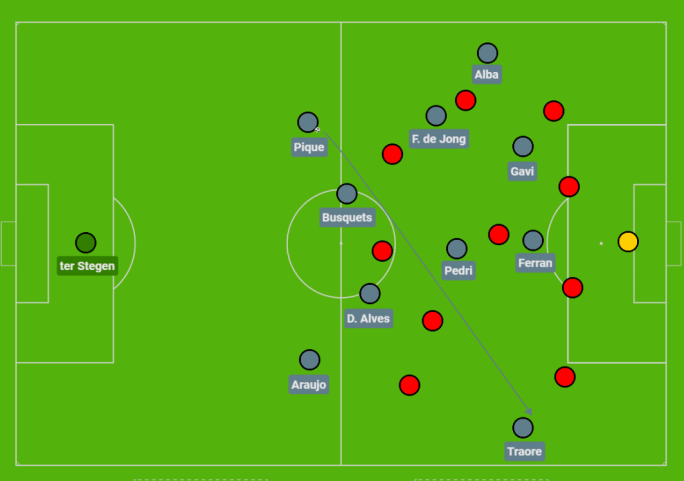
As a football analyst, I often get asked a very broad question – ‘How do you watch football matches?’. What people really want to know is what I look for, the process of watching to disseminating that information to an audience, and how they can learn more about the game to see football like a true tactical analyst themselves. A little over a year ago, I wrote an article titled ‘How to watch football like a tactical analyst‘, following a ‘how do you watch football?’ type of question from one of our long-time readers. Since that article, the way I watch football has evolved, with new processes and techniques to study the game and prepare myself for the subsequent analyses that follow. So with that, today I share how I watch football matches, and gain the necessary insights that guide my articles.
HAVING A PLAN

Like most things in life, preparation is important to success. I love the spontaneity of life, particularly in football, and how you can never predict what is going to happen. But I also believe in the benefit of going into every football match with a plan for what you want to identify and study. That could be a player, a pattern, what a team does in possession, out of possession, in transition, or a mix of all of the above. But having that specific aspect guide my focus helps me pay greater attention to the minutia of a match, and study everything else going on within that context. If I don’t have something specific that I’m looking for, I tend to be less engaged and sometimes even struggle to focus on the match in front of me. Speaking of focus, I almost always turn the commentary off, to ensure my thoughts are the only thoughts inside of my head, and that I’m not being influenced by what the commentators or pundits say about the game. Then when it comes to having a pre-determined plan, it’s important not to give yourself too much to study.

The hardest thing that you can do when analyzing a football match is to try and watch both teams simultaneously. You simply miss out on so much that is happening if you’re just following the ball and the phase of play in the moment, without studying everything else that’s happening off the ball. You have to remember that there’s 22 players, and only 1 ball. What the other 21 are doing to react to the player on the ball is more important than the ball carrier themselves. Further, a professional player spends about 2-3 minutes on the ball over a course of a 90 minute game. What they’re doing for that other 87-88 minutes is so much more important. So unless I know that I want to write a Match Analysis where I’m going to be dissecting the finer details of both teams (like I did with both Chelsea-City encounters this season), I specifically guide my focus toward one team, or even one player. By doing so, I find I’m actually able to get a clearer picture of the other team or other players too, because everything they are doing is now framed into the context of the opposition, rather than trying to study both at the same time and not having a clear understanding of how each team is reacting to the other. Even in match analyses like Canada 2-0 USA, I’ll still usually watch one team at a time, write some notes, and then focus on the other. Again, doing so helps guide my focus toward what I’m looking for.
BREAKING DOWN THE GAME

I recently talked to a coaching friend over in England – Sam Holmshaw – about the importance of framing everything into your own context, and compartmentalizing the game in a way that makes sense for you. The same goes for analysis. What works for me, might not work for you, because we may see the game differently. But when I’m watching football matches, I’m always looking to break down the game into the thirds, and correlate that to team structure and shape, style, principles and patterns of play, and individual player habits both in and out of possession. It’s no secret that what a team does when defending in the final third is very different to what they do when defending in their own third. On one hand, a team may be trying to win back possession for the purpose of scoring goals, and at the other end, the alarm bells are ringing in their attempt to stop goals. Due to these important discrepancies, it’s important to break down in possession and out of possession phases between the three thirds (first, middle and final third), and identify the over-arching structures, shapes, player habits, patterns, etc. within each third and within each phase. To say that Chelsea defend in a 3-4-2-1 formation would be incorrect, as it’s only the shape they adopt in their high block to high press, rather than their low to mid block, which tends to be more 5-4-1.
When it comes to a match analysis rather than an in-depth team analysis, patterns are particularly important.

If you can identify anything that’s repeatedly occurring over the course of a match, potentially something that is even different to what the same team has done in matches prior, that is incredibly valuable information to highlight. When it comes to an in-depth pieces on specific teams, it’s almost the opposite. I’m carefully ignoring patterns that only come up in a single game, and looking for over-arching structures that repeatedly occur over a five to ten game period.
TAKING NOTES

When talking about the “how” of it all, I like to have my notes set-up in a way that makes the process seamless. In time, I’ll give this away as a freebie for anyone who wants to do the same. But essentially, I break down each team into the three defensive phases (low-block, mid-block and high-block) and three attacking phases (build-up, progression and creation), each holding a separate column on my notepad. For my own context of what makes sense to me, I include transitions and set-pieces within that frame (i.e. a team’s attacking corner kicks go in the creation column, rather than separate). For a player analysis, the columns might be different – such as including a ‘strengths & weaknesses’ section, or analyzing a player’s ‘4 Corners‘.
If this all sounds like too much for you, I would still recommend compartmentalizing the game and separating what you are scanning for into columns that makes sense for you. The easiest way to do this is to have two separate columns or pages, one titled “IN POSSESSION”, and one that says “OUT OF POSSESSION”. You’ll notice most of my articles are framed around these two headings, so it’s helpful for me to have that separation, rather than needing to sift through my notes to find the discrepancies.

In terms of taking notes, it’s also important to do so at a time where you are not missing the action, and to use short-forms and phrases that make sense to you. This will help you scribble in your thoughts, without missing the live action. To give you some examples of this, here are some short-forms I use to shorten the writing process:
-> POFB = Playing out from the back.
-> QATTtrans = Quick attacking transition.
-> Counter-P = Counter press.
-> Counter-A = Counter attack.
-> Opp. = Opposition.
-> GKs = Goal kicks.
I’ll even go as far as to short-form player names (e.g. Allan Saint Maximin = ASM), positions (this is a must!! e.g. LCM = left central midfielder), and team names (use their abbreviations…. e.g. WHU = West Ham United). This can ensure you spend less time writing your thoughts, and more time absorbing the evolution of the game.
Then, once the match is fully over, or I’ve seen enough over the course of several matches, I’ll begin the writing process. Truthfully, that undertaking is always going on in my head as I’m writing notes, and thinking about how I would frame ideas into sentences that resonate with my audience. But in the actual writing of an article, I’m never listening to a match like its a radio program while typing away. If I tried to do so, I’d simply miss important information.
Finally, for anyone that wants to learn more about how I make my graphics, see my video on How to make football graphics with Planet Training.
CONCLUSION

When it comes to analyzing football matches, each tactical analyst may watch for different things that are of interest to them. Each may also compartmentalize the game and break it down in different ways for their brain, making the process of watching the evolution of a match seamless. So in trying to get on the level of an Alex Stewart or Michael Cox, it’s important to identify how you see the game, and use that to guide how you scan for everything from patterns to principles, shapes, structures and more.
So there it is! How I watch football matches for the tactical analyses that you see on this site. Be sure to check out more of our Tactical Theory based articles, and follow on social media @mastermindsite via the links below. Thanks for reading and see you soon!
YOU MIGHT ALSO ENJOY…
Pep Guardiola – Manchester City – Tactical Analysis (2023-24)
This might finally be the year. It might finally be the year that Pep Guardiola and Manchester City don’t win the Premier League. Despite that, they’ve still been the most tactically complex team in the league, carrying on from much of the tactics that brought them a treble-winning triumph last season. Here is what Pep…
Game of Numbers #38 – Alejandro Garnacho’s intensity & awareness
It’s amazing to think that Alejandro Garnacho is only 19 years of age. Sometimes, you can see the rawness in his game. The facets that still need to be carefully developed. But as he ages, let’s hope he never loses his tenacity. His hunger for more. His appetite to win at all costs, even when…
The EFL Championship’s most invigorating title race in years
For the longest time, Leicester City looked favourites for the EFL Championship title. Few competitions in the world of football can match the Championship for drama, but this 2023-24 campaign has now taken on a new level of excitement ahead of Easter Monday’s round of fixtures. Four teams remain in the hunt for the title…

This article is part of our Introduction to Football Analysis – Online Course with Rhys Desmond. See what else is in store for the course and navigate to the next section below.
See the entire course curriculum and jump around by visiting:
Introduction to Football Analysis – Online Course with Rhys Desmond
about the author
rhys desmond
CEO, FOOTBALL ANALYST

FOLLOW on social media / contact
As the founder of TheMastermindSite.com back in 2016, I have worked tirelessly to create one of the biggest tactics & analysis websites the beautiful game has to offer. Combining my knowledge of writing, coaching, analysis and the game as a whole, I want to help you take your craft to the next level.
In 2020, I helped undergraduate students at Western University in London, ON, develop their coaching craft, in a three month Coaching & Leadership course. A month later, I began my path as the Technical Director of the club I started my coaching career with, helping coach, mentor and develop close to 100 coaches. In 2021, I began working with current and former professional players, helping them develop their knowledge and ideas about the game, improve their performance and prepare for life in the coaching world. Throughout that time, I accumulated training through MBP and the PFSA in the realms of analysis, scouting and performance-based football; the OS, CSA, and HighFive in coaching & mentorship; and worked with coaches around the world from 20+ nations. In 2023, I am now back at Western University as a Lecturer, teaching their Coaching & Leadership course to 50+ undergraduate students.
Since the start of my mentorship masterclass, I have worked with professional players, former pros developing their coaching craft, industry-leading writers, and community coaches. Not every professional environment has the ability to afford a performance analyst, so I offer a cheap option for pro players and coaches to take their knowledge and game understanding to the next level, developing solutions, training techniques and tactical understandings through the analysis of video footage in a 1-on-1 setting where continuous feedback can be applied.
If you are interested in taking your footballing craft to the next level, simply fill out the contact form, or email rhys@themastermindsite.com.





13 thoughts on “How I watch football matches for tactical analyses”